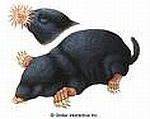Mole
Scapanus
 |
|
The mole is a small, dark brown, furry, insect-eating mammal. Contrary to a commonly held belief, it is not part of the rodent family. In California, moles inhabit the Sierra Nevada, the coastal range mountains and foothills, as well as the entire coastal zone. They are not usually found in the dry southeastern regions of the state or in much of the Central Valley except for moist areas where the soil is rich in humus, such as riverbanks. Moles have cylindrical bodies with slender, pointed snouts, and short, bare, or sparsely haired tails. Their limbs are short and spadelike. Their eyes are poorly developed and their ears are not visible. The fur is short, dense, and velvety. Moles have one litter of three or four young during early spring.
Habits
Moles live almost entirely underground in a vast network of interconnecting tunnels. They frequently create shallow tunnels just below the surface where they capture worms, insects, and other invertebrates. They can eat some roots, bulbs, and other plant material, but generally the greatest problem caused by moles is their burrowing, which dislodges plants and dries out their roots. In lawn areas, the mounds and ridges resulting from their burrowing are unsightly and disfiguring.
Habitat
In California, moles inhabit the Sierra Nevada, the coastal range mountains and foothills, as well as the entire coastal zone. They are not usually found in the dry southeastern regions of the state or in much of the Central Valley except for moist areas where the soil is rich in humus, such as riverbanks.
Threats
Moles can cause significant problems in landscape or garden areas, especially in turf. Because mole damage can be unsightly, makes lawn maintenance difficult, and destroys valuable plants, the number of moles that can be tolerated is usually quite low, sometimes even zero. As soon as you see an active mound or surface runway, initiate appropriate control actions. Once you have controlled damage, establish a system to monitor for reinfestation.
Prevention:
Many methods of prevention are available and a combination of them may be necessary. Trapping is the most common. Baiting, flooding and use of repellants are other posibilites. We suggest you call Hydrex Pest Control. We have the knowhow and the patience to persue these tough to get creatures.


